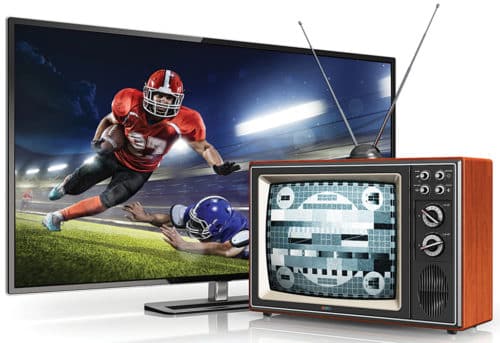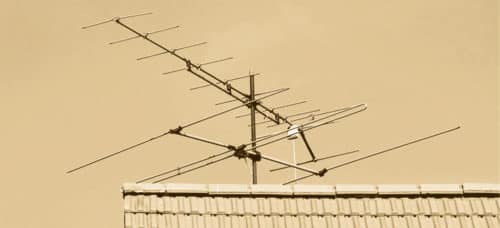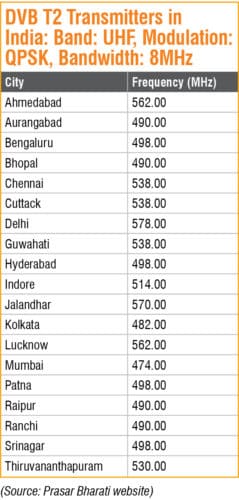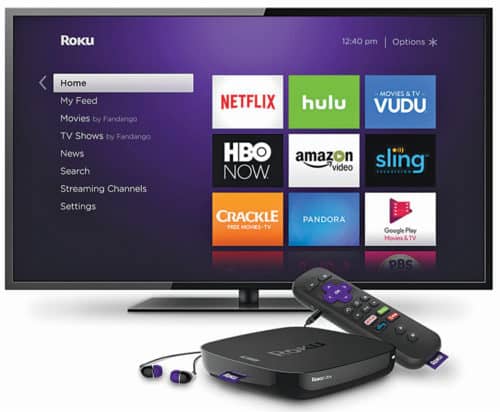Today, public demand is towards video information and entertainment, and the preferred choice of the user terminal is the ever-present smartphone.
Television (TV) technology has undergone substantial changes since its arrival in India six decades ago. The first TV transmitter was set up in 1959 at New Delhi, followed by Mumbai in 1972. Further progress in TV broadcasting was made in 1976, when India embarked on Satellite Instructional TV Experiment (SITE) via ATS 6 satellite taken on loan from NASA, and educational TV programmes were beamed to India from ATS 6. Users were introduced to dish antenna as a means to receive TV programmes.
Terrestrial transmitters were also started by Doordarshan India (DDI) in VHF band I (41MHz – 68MHz) and band III (174MHz – 216MHz). In the initial phase, carrier frequencies in the UHF and C bands were used for satellite broadcasting, which required a large dish antenna for reception. Satellite TV gained popularity when Ka and Ku band receivers were developed, and a small 60cm dish antenna could be used to receive signals from geostationary satellites.
Antenna on the geostationary satellites can be designed to generate a footprint required to cover the target geographical area. Thus, tailor-made beams can be generated to save power as well as take care of possible objections from population outside the boundary.
Developments in the field of data compression have brought dramatic reduction in bandwidth requirements. Encryption of data bit-streams also facilitates control of paid channels by service providers. Paid channels have gained consumer confidence, and the concept of free-to-air (FTA) channels has faded with time. The analogue TV finally closed down in India on January 13, 2018. As most of the viewers had already switched over to satellite-based DTH systems, no one even noticed it!
Analogue TV
The analogue TV, operating in VHF channels on standard PAL B and G bands, transmits video signal modulated on the carrier using vestigial side-band (VSB) technique.
Accompanying sound frequency is modulated on a separate carrier frequency. Total bandwidth of the TV signal is about 7MHz or 8MHz.
VSB signal is decoded in the receiver, and luminance as well as colour information is separated. The audio carrier is demodulated to recover audio channel. These three output signals, composite video containing luminance and colour signals, along with left and right stereo audio channels, together constitute the intelligence to be presented on the display device and speakers.
SITE TV programmes were beamed to ground at 860MHz, using frequency modulation for video signals. Indian Space Research Organization (ISRO) took on a major role and undertook the responsibility of designing high-reliability receiver sets. ISRO established regional centres for generation of programmes, handling of community TV sets and uploading of programmes to the satellite.
Cable TV came to India at the same time as satellite TV. In case of analogue cable TV, VSB modulation was used for the base band as in the case of terrestrial analogue TV, while RF carriers in the range of 40MHz to 600MHz were employed.
Digital TV
A video signal is generated by means of scanning the source picture at the frame rate of 25 per second to reduce flicker. Successive frames contain very similar information, so removal of redundant data helps save bandwidth.
In case of digital TV, pixel-wise data in each frame is stored, and redundant information is removed with the help of appropriate compression algorithm. The compressed digital video, formatted along with accompanied audio and other information, modulates a carrier in VHF, UHF or microwave bands, as per requirements of the transmission standard.
At the receiving end, demodulation and reconstruction of information is, at present, carried out in a unit called set-top box (STB). Subsequently, the reconstructed video and accompanied audio signals are interfaced to a regular TV receiver used as display device.

Digital satellite TV (DVB-S/S2)
Digital satellite TV broadcasting uses Digital Video Broadcasting – Satellite (DVB-S) and upgraded DVB-S2 standards. The video signal and accompanied audio are digitised, data compression is applied, and data packets modulate a carrier in Ka and Ku bands at 10GHz and 14GHz.
Single-carrier quadrature phase shift keying (QPSK) is used for modulation of information. Signals are transmitted to ground by means of geostationary satellite in Earth’s orbit and received by a 60cm parabolic reflector antenna looking towards the satellite. Antenna feed is integrated with a low-noise amplifier and a down converter to convert RF signals in 10GHz – 14GHz band to a lower frequency of 950MHz – 2150MHz, called first intermediate frequency. This entire unit, called low-noise block (LNB), is mounted on the focal point of the parabolic dish.
The 950MHz – 2150MHz IF signal is brought down by means of a coaxial cable, to interface to an indoor STB. The latter down-converts this IF to a lower frequency, amplifies and demodulates it to recover the digital bit-stream. The latter is processed in the LSI device under program control. The separated-out video and audio information consist of three signals—composite video, audio L and audio R—which are interfaced to the display unit.
Digital cable TV (DVB-C/C2)
Digitisation of cable TV has also been implemented in a similar way. Digital bit-stream, in case of DVB-C/C2, is similar to the one used in case of DVB-S/S2 standard. Quadrature amplitude modulation (QAM) is used for modulating the signal onto an RF carrier in 47MHz – 862MHz frequency range. DVB-C/C2 differs only as much that, input RF received from the cable is in VHF/lower UHF range—rest of the processing is similar to that described in case of DVB-S/S2.
Digital terrestrial TV (DTT)
Digital Video Broadcasting – Terrestrial (DVB-T/T2), utilises VHF/UHF carriers in 174MHz – 862MHz range, and can transmit eight sub-channels in the space used by 8MHz analogue TV channels. In case of DTT, signals are transmitted as data compressed digital bit-stream modulated on a carrier in UHF band, similar to the ones allotted earlier to analogue UHF TV. Since signal is prone to multi-path and fading, orthogonal frequency division multiplexing (ODFM) is used to transform digital bit-stream to a frequency multiplex.

In case of DTT, a simple UHF Yagi antenna is used for signal reception. An STB, designed for DVB-T/T2 operation, is used to recover and decode digital bit-stream, and reconstruct video as well as audio. Since DTT requires a simple installation, it may be handled by viewers themselves.
Doordarshan is broadcasting at present five sub-channels in one digital channel. Currently, DD National, DD News, DD Bharati, DD Sports and DD Regional/DD Kisan are supported on one channel. Channel frequencies used in India are given in the table. Frequency range extends from 470MHz – 562MHz. The ~100MHz bandwidth required in the antenna can be easily achieved in a suitable Yagi antenna. TV sets capable of handling DVB-T/T2 standard are a few at present.

Internet Protocol TV (IPTV)
Internet Protocol TV is rather different. Typically, an Internet connection is made available to the telephone subscriber with the help of a signal splitter to separate low-frequency audio signal used in telephony, and the high-frequency phase modulated sub-carrier. The copper connection to the telephone subscriber’s public switched telephone network (PSTN) is capable of transmitting high-frequency signals apart from low-frequency signals needed for telephony. This property is used to realise advanced digital subscriber line (ADSL) connection.
Data bit-stream, available in an Internet connector, is decoded, and video and audio information is separated. This is performed in a specific STB, under program control. The unique feature here is that video signal is accommodated within the pass band available in the telephone line by data compression.
Signal recovery at the user end requires processor power to accomplish signal separation and decompression. Unique feature in case of IPTV is that, the user sees only one programme at a time, and connection to the exchange is bi-directional. Therefore the user can send a command via remote control to select any programme of his or her choice. The service provider, in turn, directs data pertaining only to that programme to the user.
Use of Wi-Fi modem enables multiple users to use the IPTV. Introduction of fibre-optic broadband connection enhances the data rate significantly and facilitates multiple users to access programmes of their choice simultaneously.

Challenges in TV receiver design
Barring IPTV, all other standards require RF systems at the input end of a TV receiver. All digital TV base-band signals utilise a digital bit-stream of more or less similar structure, except for DVB-T/T2, which requires additional OFDM step. The difference lies in the use of certain RF carrier frequencies and code variations specific to the standard. The software for signal extraction would therefore differ in case of DVB-S/S2, DVB-C/C2 and DVB-T/T2.
This is not a big problem, as the programme can be altered by input data itself as per requirement. As of today, DVB-C/C2, T/T2 and S/S2, all need a separate and unique STB, differing from each other mostly in RF circuitry, to interface to the user TV. IPTV too needs a different STB, as it does not depend on the RF carrier.
Digital cable and satellite channels, made available by private service providers, utilise encryption to facilitate collection of subscription from users. DVB-T/T2 or DTT, on the other hand, is an FTA broadcasting system radiating on standard UHF carriers. A TV with built-in DVB-T/T2 tuner can therefore be connected to UHF Yagi antenna to receive signals, without the need of a separate DVB-T/T2 STB.
In principle, RF sections of the STB for DVB-C/C2, DVB-T/T2 and DVB-S/S2 standards are similar, in that all of these have to be able to recover digital bit-stream from a VHF/UHF carrier. Separation and reconstruction of video and audio signals can be accomplished by a unified decoder under program control. This paves the way for the design of a unified digital TV receiver called integrated digital TV (iDTV) receiver.
Paid channels managed by service providers can be taken care of by incorporation of user-replaceable SIM (subscriber identity module) cards, as used in cellphones. Addition of adequate processing power has resulted in the smart TV, which is capable of handling signals available from a USB port, Wi-Fi or Internet port, in addition to satellite, terrestrial and cable.
The smartphone as a user terminal
Arrival of the cellphone in the year 2000 and its amalgamation with the palm-top computer has made it emerge as the smartphone, and has revolutionised the concept of information interchange. The smartphone is capable of handling audio as well as video information, and sharing the same between users.
Internet connectivity has ushered in an era where a large amount of all sorts of information is available at one’s fingertips. Therefore any broadcast technology has to recognise the dominance of the smartphone in public life and ensure compatibility, for wider acceptance.
One mode of watching DVB-T2 programmes would be via a dongle containing all RF circuits pertaining to UHF TV, including bit-stream handler and decoder. The dongle requires a UHF antenna to pick up radiated signals, and an Android app needs to be downloaded to the device for the DTT dongle to work. Many Wi-Fi routers are available in the market, which can be simply plugged to a power point at home to receive DTT signals, to serve Android devices, located nearby.
Conclusion
Today, public demand is towards video information and entertainment, and preferred choice of the user terminal is the ever-present smartphone. Any technology, to get a hold on public attention, needs to be compatible to the cellphone. The DTH satellite service is quite popular, while the simple DVB-T2 system that uses the standard Yagi antenna for reception has not penetrated the market due to lack of information as well as the relative absence of DTT receivers.
Cable TV competes with satellite TV, and blackout of Ka and Ku band signals during rains gives an edge to cable TV. IPTV and cable TV would be at par in this respect.
R.N. Misra, an Allahabad University and Roorkee University (now IIT) alum, was formerly with Physical Research Laboratory, Ahmedabad, and worked there for more than forty years in development of space instrumentation.












Excellent information on all types pf TV transmissions.
Thank you for your feedback.
EFY TEAM could relate to the information right from going up on the bldg terrace to see the TV tower from our IIT campus home. Inn the mid 70’s, rukawat ke liye khed hai or the Color Bar with 1kHZ tone also enjoyed high TRP as people had patience and time at hand.
i presently work in the audio engineering front of TV show production and was trying to understand the frequency bandwidth allocation with the end of analogue TV and vacant band with utilization and 5G spectrum sale.